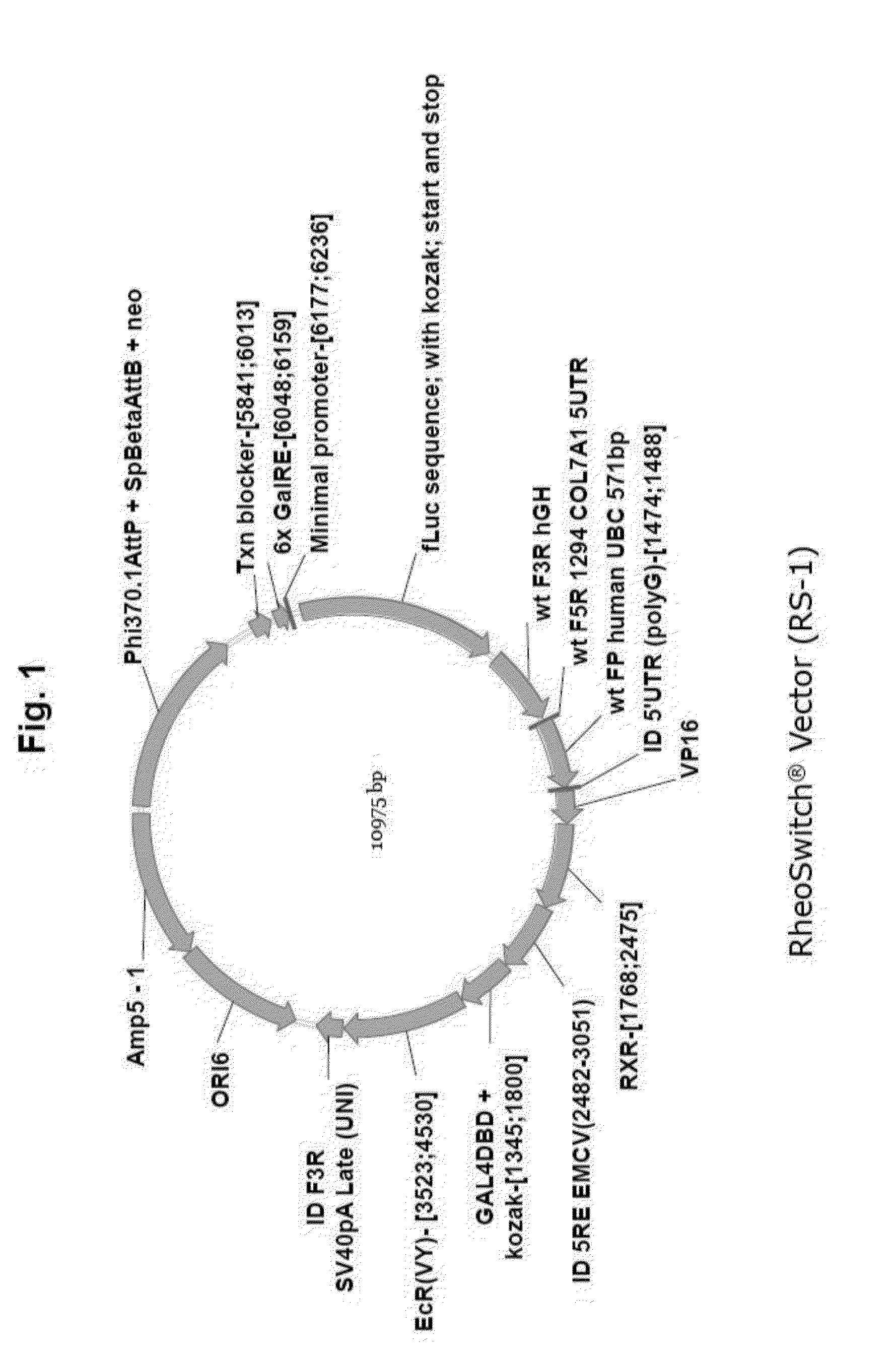Boron-containing diacylhydrazines
a diacylhydrazines and boron-containing technology, applied in the field of biotechnology, genetic engineering, gene expression, medicinal chemistry, can solve the problems of system leakage, limited use of pr1-a, and system limitations
- Summary
- Abstract
- Description
- Claims
- Application Information
AI Technical Summary
Benefits of technology
Problems solved by technology
Method used
Image
Examples
example 1
Synthesis of N′-(tert-butyl)-N′-(3,5-dimethylbenzoyl)-1-hydroxy-1,3-dihydrobenzo[c][1,2]oxaborole-6-carbohydrazide (Cpd. No. 50)
[0527]
Step 1: Synthesis of 3-borono-4-methylbenzoic acid
[0528]
[0529]3-Bromo-4-methylbenzoic acid (11.00 g, 51.2 mmol) was dissolved in anhydrous THF (150 ml) under argon in a 500 ml 3-necked round bottom flask fitted with two dropping funnels and argon inlet. The stirred solution was cooled to −78° C. and n-BuLi (1.6M in hexane, 60.7 ml, 97.0 mmol) was added drop wise from a dropping funnel (during 1 h). After completion of the addition, the solution was stirred at −78° C. for another 1 h. To this, B(OMe)3 (17.7 ml, 159.0 mmol) was added slowly from a second dropping funnel. The mixture was stirred 1 h at −78° C. and then warmed up to room temperature overnight. The solvent was evaporated under reduced pressure. The crude product was dissolved in ether and poured into aqueous HCl (1N). The mixture was extracted with ether (3×150 ml), and the combined organi...
example 2
Synthesis of (R)—N′-(3,5-dimethylbenzoyl)-N′-(2,2-dimethylhexan-3-yl)-2-hydroxy-9-methyl-2,3,4,5-tetrahydrobenzo[f][1,2]oxaborepine-8-carbohydrazide (Cpd. No. 70)
[0577]
Step 1: Synthesis of methyl 3-hydroxy-2-methylbenzoate
[0578]
[0579]To a IL 3-necked round bottom flask equipped with a condenser and magnetic stirrer was added 3-Hhydroxy 2-methyl benzoic acid (15.2 g, 100 mmol) and anhydrous MeOH (400 ml). To this, 7 ml of conc. H2SO4 was added and the mixture was refluxed overnight under argon. LCMS showed complete conversion to the product. The reaction mixture was collected and the solvent was removed under vacuum. The crude mixture was diluted with ethyl acetate. After aqueous work up and extraction with ethyl acetate, the mixture was purified using an ISCO system (120 g silica gel column, hexane:ethyl acetate solvent mixture) to give the methyl benzoate derivative (major peak, eluted with ˜12% EtOAc in hexane) in 84% isolated yield. 1H NMR (400 MHz, CDCl3) δ 7.57 (dd, J=7.8, 1.0 ...
example 3
Synthesis of (R)-(3-(4-(2-(3,5-dimethylbenzoyl)-2-(2,2-dimethylhexan-3-yl)hydrazinecarbonyl)-2-methoxy-3-methyl-phenyl)propyl)boronic acid (Cpd. No. 27)
[0607]
Step 1: Synthesis of (R)-4-allyl-N′-(3,5-dimethylbenzoyl)-N′(2,2-dimethylhexan-3-yl)-3-methoxy-2-methylbenzohydrazide
[0608]
[0609]To a solution of SKC-03-023 (500 mg, 1.11 mmol) in anhydrous acetone (5 ml) in a 1-neck 100 ml round bottom flask fitted with a reflux condenser, at room temperature under argon was added anhydrous K2CO3 (169 mg, 1.22 mmol). The reaction mixture was stirred at 50° C. for 30 min. To this, MeI (0.104 ml, 1.66 mmol) was added, and the reaction mixture was stirred overnight at 50° C. LCMS showed it to be a clean reaction. The reaction mixture was diluted with EtOAc and filtered to remove K2CO3. The filtrate was dried under vacuum. The crude mixture was adsorbed on silica, dried to make it free flowing, loaded on a cartridge, and purified using an ISCO system (24 g silica column, hexane / EtOAc gradient). Th...
PUM
| Property | Measurement | Unit |
|---|---|---|
| enantiomeric excess | aaaaa | aaaaa |
| enantiomeric excess | aaaaa | aaaaa |
| enantiomeric excess | aaaaa | aaaaa |
Abstract
Description
Claims
Application Information
 Login to View More
Login to View More - R&D
- Intellectual Property
- Life Sciences
- Materials
- Tech Scout
- Unparalleled Data Quality
- Higher Quality Content
- 60% Fewer Hallucinations
Browse by: Latest US Patents, China's latest patents, Technical Efficacy Thesaurus, Application Domain, Technology Topic, Popular Technical Reports.
© 2025 PatSnap. All rights reserved.Legal|Privacy policy|Modern Slavery Act Transparency Statement|Sitemap|About US| Contact US: help@patsnap.com



